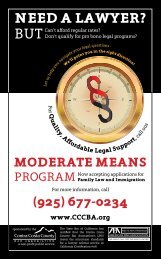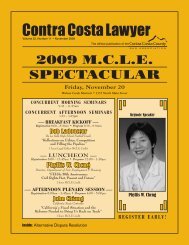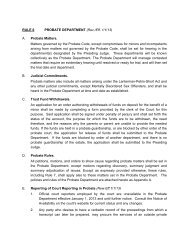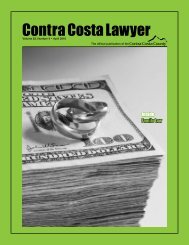download - Contra Costa County Bar Association
download - Contra Costa County Bar Association
download - Contra Costa County Bar Association
Create successful ePaper yourself
Turn your PDF publications into a flip-book with our unique Google optimized e-Paper software.
Elements of ATRA<br />
The American Taxpayer Relief<br />
Act (ATRA) became law<br />
on January 2, 2013.<br />
ATRA: (1) repealed the<br />
sunset of the Economic Growth<br />
and Tax Relief Reconciliation Act<br />
of 2001 (EGTRRA); (2) increased tax<br />
rate; (3) increased the capital gains<br />
rate; (4) re-introduced the “stealth”<br />
taxes by reduction of itemized deductions<br />
and personal exemptions;<br />
(5) created “permanent” alternative<br />
minimum tax relief; and (6) extended<br />
estate and gift tax exemptions<br />
established in 2010.<br />
ATRA relief retained some of the<br />
Bush-era tax policies and avoided<br />
government spending cuts, although<br />
resolution of the debt ceiling<br />
question has only been deferred.<br />
ATRA was a compromise. The<br />
administration wanted higher tax<br />
rates on incomes of at least $250,000<br />
(citing those successful families and<br />
individuals as “rich”), while Republicans<br />
resisted higher rates. The definition<br />
of rich settled at singles making<br />
over $400,000, and $450,000 for<br />
married joint filers.<br />
Repeal of EGTRRA<br />
Sunset<br />
EGTRRA provided significant tax<br />
breaks from 2001 through 2012, particularly<br />
in the area of capital gain<br />
rates, estate taxes and gift taxes.<br />
EGTRRA was scheduled to sunset<br />
after 2010, meaning that we would<br />
return to higher tax rates in effect<br />
before 2001. Both sides agreed to defer<br />
the EGTRRA sunset at the end of<br />
2010 to December 31, 2012, at which<br />
time the government would face its<br />
self-imposed fiscal cliff.<br />
When the dust settled, both sides<br />
claimed victory when they made<br />
by G. Scott Haislet<br />
EGTRRA permanent under ATRA,<br />
with no possibility of sunset in the<br />
future.<br />
Income Tax Rates<br />
ATRA retained existing 10 percent,<br />
15 percent, 25 percent, 28 percent,<br />
33 percent and 35 percent rates<br />
that prevailed pre-ATRA. Absent<br />
ATRA, these rates would have been<br />
materially higher.<br />
ATRA added a 39.6 percent rate for<br />
income above the applicable threshold<br />
of $400,000 for single taxpayers,<br />
$450,000 for married joint filers and<br />
$425,000 for heads of household.<br />
The applicable threshold will be<br />
adjusted annually for inflation.<br />
The tax brackets on which income<br />
is taxed at 10 percent, 15 percent, 25<br />
percent, 28 percent, 33 percent and<br />
35 percent will be adjusted annually<br />
for inflation. These favorable<br />
policies retain the “bracket creep”<br />
avoidance policy dating from the<br />
1980s.<br />
Capital Gain Rates<br />
ATRA retained the zero percent<br />
and 15 percent long-term capital<br />
gain rates. That means zero percent<br />
capital gain rate will apply to gains<br />
that would otherwise be subject to<br />
10 percent or 15 percent ordinary<br />
rate; 15 percent will apply to gains<br />
that would otherwise be subject to<br />
25 percent, 28 percent, 33 percent or<br />
35 percent ordinary rate.<br />
ATRA imposes a 20 percent longterm<br />
capital gain rate on income<br />
above the applicable threshold (e.g.,<br />
above $450,000 for married joint filers<br />
and $400,000 for singles). That<br />
means that 20 percent capital gain<br />
rate will apply to gains that would<br />
otherwise by subject to the 39.6 percent<br />
ordinary rate.<br />
For example, it will be possible<br />
for a gain to be taxed partially at 15<br />
percent and partially at 20 percent.<br />
Long-term capital gain rates will apply<br />
to gains on sales of capital assets<br />
and on “qualified” dividends. A dividend<br />
is qualified if taxpayer holds<br />
the stock at least 61 days during the<br />
121-day period that begins 60 days<br />
before the stock goes ex-dividend.<br />
Note: a new 3.8 percent tax will<br />
apply to net investment income<br />
(interest, dividends, gains, etc.) for<br />
those with “modified” adjusted gross<br />
income of $200,000, and $250,000 for<br />
married joint filers; that tax began<br />
January 1, 2013, under federal tax<br />
code section 1411, which was adopted<br />
by Congress in 2010. Thus, top<br />
federal long-term capital gain rates<br />
are effectively 23.8 percent.<br />
12<br />
MARCH 2013
















